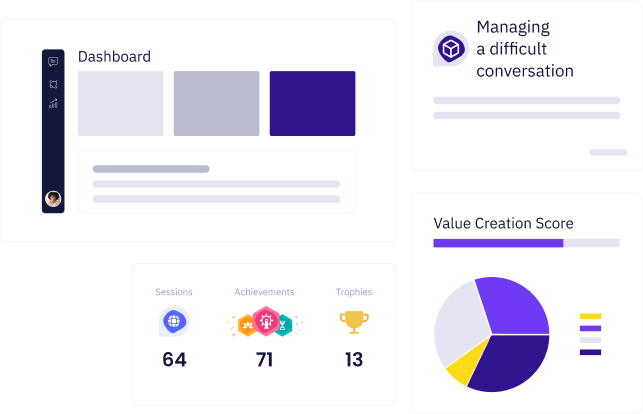The role of a leader or an executive in an organization is akin to that of a captain steering a ship through turbulent waters. They are responsible for guiding their team towards the desired destination while ensuring a smooth and productive journey. However, this journey can only become directionless with a well-defined map and a clear destination vision. Various studies suggest that many leaders and executives may need a well-defined performance strategy to navigate their responsibilities and guide their organizations toward peak performance. This lack of strategic direction can lead to inefficient decision-making, employee engagement, and ineffective strategic planning.
A research study from Splunk highlights the importance of data-driven decision-making, indicating that 69% of data innovators consider their company culture “data-obsessed.” Data innovators enjoy better business outcomes and extract greater economic gains from their data. These innovators have the right culture, bringing data to everything they do and leveraging AI more extensively than their lower-performing peers.
The Role of Performance Metrics in Executive Decision-Making

Performance metrics play a crucial role in executive decision-making. These metrics are quantifiable measures used to gauge the performance of various aspects of an organization, such as individual employees, teams, departments, or the organization as a whole. For executives, performance metrics provide valuable insights into the effectiveness of current strategies and initiatives, allowing them to make informed decisions about resource allocation, goal setting, and strategic planning.
Quantifying performance provides actionable insights for decision-making processes by offering concrete data points that can be analyzed and interpreted. Instead of relying on gut feelings or intuition, executives can base their decisions on empirical evidence, reducing the risk of making costly mistakes. Performance metrics also enable executives to track progress over time, identify trends and patterns, and make adjustments as needed to ensure that organizational goals are met.
Executives utilize a variety of performance metrics to drive business outcomes effectively. These metrics can be broadly categorized into financial metrics, operational metrics, and strategic metrics. Financial metrics, such as revenue growth, profitability, and return on investment (ROI), provide insights into the financial health and performance of the organization. Operational metrics, such as productivity, efficiency, and quality, measure the effectiveness of operational processes and workflows. Strategic metrics, such as market share, customer satisfaction, and brand reputation, evaluate the organization’s strategic position and competitive advantage in the marketplace.
Leveraging Data for Performance Quantification
Data sources, analytics techniques, and AI applications provide executives with the tools they need to collect, analyze, and interpret vast amounts of data quickly and efficiently. By leveraging data and AI, executives can gain deeper insights into performance metrics, identify opportunities for improvement, and make data-driven decisions that drive business success.
Executives gain valuable insights into their organization’s performance through daily conversations with performance strategists. Leveraging AI technology, these discussions are summarized into daily chat reports, enabling swift identification of strengths, weaknesses, opportunities, and threats (SWOT) on the spot. These real-time SWOT analyses are then aggregated and integrated into executive dashboards. This dynamic approach empowers executives to pinpoint pain points promptly and devise effective strategies for resolution.
Analytics techniques such as descriptive analytics, diagnostic analytics, predictive analytics, and prescriptive analytics enable executives to analyze historical data, diagnose problems, predict future outcomes, and prescribe recommended actions.
Case studies illustrate how successful organizations integrate data-driven performance quantification with AI into their decision making processes. For example, a retail company may use AI-powered demand forecasting models to predict customer demand accurately, optimize inventory levels, and minimize stockouts and overstock situations. Similarly, a healthcare provider may use AI-driven predictive analytics to identify patients at high risk of readmission, personalize treatment plans, and improve patient outcomes.
Cutting Costs through Performance Optimization
One of the primary benefits of quantifying performance and adopting data-driven decision-making skill is the ability to identify cost-saving opportunities and optimize resource allocation and operational efficiency. Executives can pinpoint areas where costs can be reduced without sacrificing quality or performance by analyzing performance metrics.
Based on performance data, strategies for optimizing resource allocation and operational efficiency include streamlining processes, eliminating waste, consolidating operations, and renegotiating contracts with suppliers and vendors.

Industry leaders might use an AI-driven platform to track employee and project performance for several purposes:
-
Identifying High Performers: By analyzing various metrics such as productivity, efficiency, and quality of work, the platform can identify employees who consistently excel in their roles.
-
Spotting Areas for Improvement: The platform can highlight areas where employees or projects are underperforming, allowing leaders to allocate resources effectively for training or process improvement.
-
Predicting Trends: Through data analysis, the platform can identify trends in employee performance or project outcomes, helping leaders anticipate future challenges or opportunities.
-
Optimizing Resource Allocation: By understanding which projects or teams are performing well, leaders can allocate resources such as budget, manpower, or time more efficiently to maximize productivity and ROI.
Such a platform offers numerous avenues for cost reduction. Through data analysis, leaders can allocate resources effectively, preventing waste. Early issue detection allows prompt resolution, averting potential costly setbacks. By recognizing and supporting high-performing employees, turnover costs are reduced. Automation of routine tasks further enhances efficiency, reducing labor expenses.
Using data insights and automation, such a platform enables organizations to operate more efficiently, optimize resource usage, and mitigate risks, ultimately leading to significant cost savings.
Driving Revenue Growth through Performance Improvement
Beyond cost reduction and efficiency gains, quantifying performance and leveraging data-driven decision-making and AI can drive revenue growth by identifying revenue-generating opportunities and tailoring products, services, and marketing strategies accordingly. By analyzing performance metrics and AI recommendations, executives can identify untapped market segments, anticipate customer needs, and deliver personalized experiences that drive customer loyalty and repeat business.
Identifying revenue-generating opportunities through performance analysis and AI-powered insights involves analyzing market trends, customer behavior, and competitor activities to identify unmet needs and market gaps.
“We are leveraging strategic management insights to drive bottom line growth through revenue acceleration and operational excellence. In concert, our team members are realizing impressive performance gains through their 1:1 work with performance strategists.”
– Navin Arora, EVP and President, TELUS Business Solutions
Navin Arora’s testimony about Impro.AI’s platform exemplifies the transformative impact of data-driven strategies in driving revenue growth and operational excellence. Using performance insights, organizations can unlock new opportunities for growth and success.
Challenges and Considerations in Implementing Data-Driven Performance Quantification
While the benefits of quantifying performance and leveraging data-driven decision-making and AI are clear, there are several challenges and considerations that executives must address when implementing these strategies. Common challenges include –
Data Quality
Data quality and accessibility are critical issues that can affect the accuracy and reliability of performance metrics and AI insights. Executives must ensure that they have access to high-quality data from reliable sources and that the data is clean, complete, and up-to-date. They must also invest in data management and governance processes to maintain data integrity and security.
Talent Shortages
Talent shortages are another challenge that can hinder the successful implementation of data-driven performance quantification and AI. Executives must ensure that they have access to the right talent with the necessary skills and expertise in data analysis, AI technologies, and domain knowledge to effectively leverage data and AI for decision-making.
Resistance to change
Organizational resistance to change is a common barrier that executives must overcome when implementing data-driven performance quantification and AI. Employees may be hesitant to adopt new technologies and processes, fearing job displacement or loss of control. Executives must invest in change management initiatives and communication strategies to address these concerns and build buy-in and support for data-driven initiatives across the organization.
Ethical and privacy concerns
Ethical and privacy concerns are also important considerations that executives must address when implementing data-driven performance quantification. Executives must ensure that they are using data and AI technologies in a responsible and ethical manner, respecting individual privacy rights and complying with relevant regulations and standards such as GDPR and CCPA.
While AI-driven decision-making holds immense potential for driving organizational success, it’s essential to acknowledge the potential risks and limitations associated with its usage. As highlighted in the article “Unleashing the Hidden Dangers of AI-Driven Decision Making,” there are hidden dangers in relying solely on AI for decision making.
AI algorithms, while powerful and efficient, can sometimes lack the nuanced understanding and ethical considerations that humans bring to the table. Therefore, it’s crucial that AI is used as a tool to augment human decision-making rather than replace it entirely. By striking the right balance between human judgment and AI-driven insights, executives can mitigate the risks associated with AI-driven decision-making and maximize its benefits for their organizations.
How Impro.AI Can Help

By using data and AI technologies, executives can cut costs, save time, and drive revenue growth, gaining a competitive advantage in their industries.
To learn more about how Impro.AI can help your organization achieve its performance goals through data-driven decision making, contact us today. Together, we can unlock the transformative potential of performance data to drive business success and achieve your organizational objectives.









